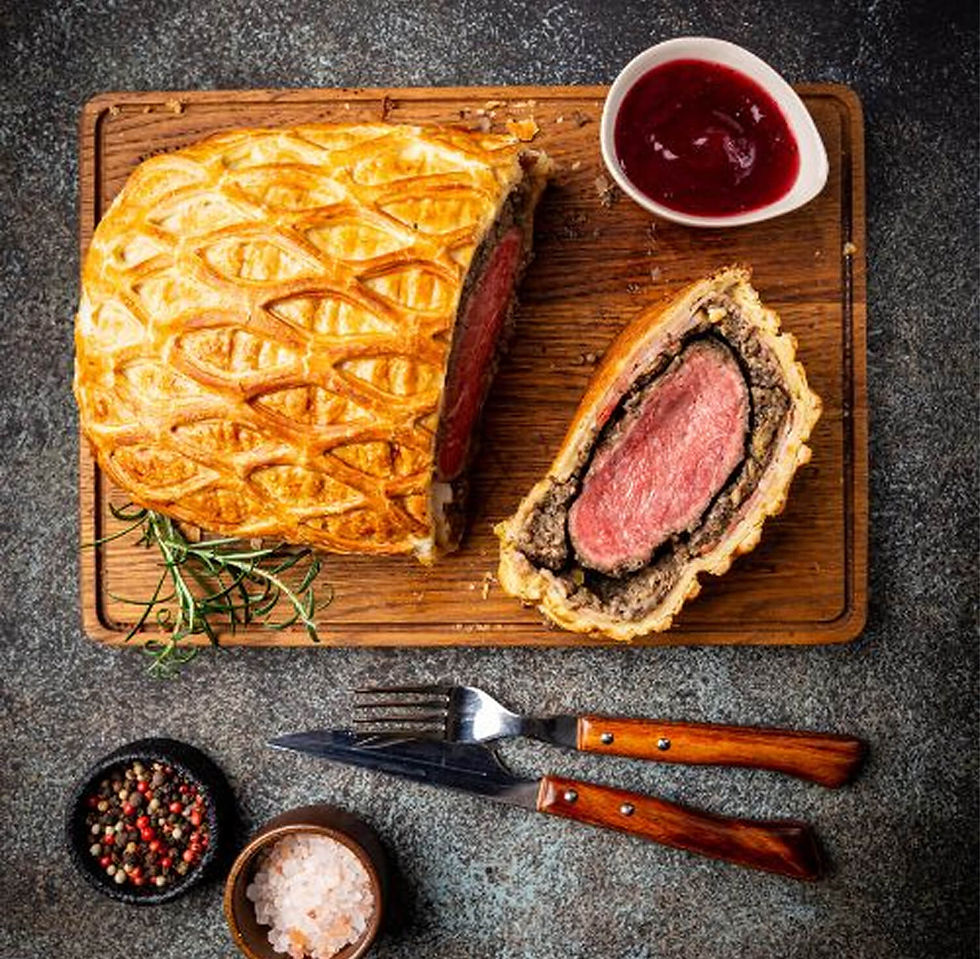Carol Ann’s Antipasto Pasta Salad—the Perfect Addition to your Labor Day Barbecue
- ckcallighan20209
- Aug 23, 2024
- 4 min read

Pasta salad is a traditional part of picnics and barbecues in my neck of the woods. Do you remember when you first ate or made a pasta salad? After reading many old cookbooks, Chris Crowley discovered that pasta salad recipes first appeared in US cookbooks in 1914. I find this fact quite strange as my mother never made pasta salads. I thought they were a creation of the 1970s as that is my first memory of eating cold pasta.
Food historians, however, believe that Jewish people have been eating cold, dressed noodles for centuries. Archeologist, Susan Weingarten, claims she found the first written mention of pasta in the Talmud, where a food called triqta is referenced. The Talmud is a record of rabbinical debates written between the 2nd and 5th centuries. Now, that is a long time ago.
Cookbook author, Marcia Freidman, believes pasta salad evolved as an Italian Jewish invention intended to make cold pasta more appetizing on Shabbat since cooking was prohibited. Makes sense to me since Italians regardless of their religion love pasta.
Irrespective of its origins, pasta salad is a quintessential part of American barbecues and is something we will be serving at my house this coming Labor Day. And a technique learned from Italian Jews, it can be made ahead of time, making holidays easier and less stressful when we are entertaining.
Try Carol Ann’s Antipasto Pasta Salad at your Labor Day barbecue. It gets rave reviews from my family.
For the dressing:
6 sun-dried tomatoes in oil, drained and chopped
⅓ cup extra virgin olive oil
2 tablespoons red wine vinegar
1 teaspoon minced garlic
1 teaspoon capers
1 teaspoon salt
¾ teaspoon large grind black pepper
In a food processor or blender, place sun-dried tomatoes, olive oil, vinegar, garlic, capers, salt, and pepper and process until almost smooth. Set aside until the pasta is cooked.
For the pasta:
12 ounces fusilli (spirals) pasta
Extra virgin olive oil
Salt
Fill a large kettle with 4 quarts of water and place over a high heat. When the water is at a solid rolling boil, add 1 to 2 tablespoons olive oil and 1 teaspoon salt to the water to keep the pasta from sticking. Add pasta to the boiling water and cook according to package directions until al dente. Transfer pasta to a colander and rinse with cold water to retard the cooking process. Drain well. Let pasta drain for 5 to 10 minutes. Transfer to a large bowl and toss gently with the dressing. Let sit while prepping the salad ingredients.
For the salad:
1 package (4-ounces) Genoa salami, sliced about 1 ½-inches in diameter
3 ounces sliced mozzarella cheese, cut into 1-inch cubes
6 sun-dried tomatoes in oil, drained and chopped
12 marinated artichoke hearts, quartered and halved
½ cup kalamata olives, drained and sliced
½ cup garbanzo beans, drained
½ red bell pepper, cored, seeded, and cut into 1-inch cubes
⅓ cup red onion, sliced thin and cut into 1-inch pieces
8 ounces cherry tomatoes, halved
1 cup grated Parmesan cheese
Basil leaves, for garnish
To the large bowl, add salami, cheese, sun-dried tomatoes, artichoke hearts, olives, garbanzo beans, red bell pepper, and cherry tomatoes. Toss gently to combine. Sprinkle with Parmesan cheese and toss gently to combine. Refrigerate salad 2 to 4 hours or overnight before serving. Garnish with basil leaves.
Tips on selecting bell peppers: Look for fresh, firm peppers that are bright and thick-fleshed with a firm green calyx and stem. Bell peppers should feel heavy for their size and have a crisp, shiny skin. Do not buy bell peppers with wrinkled skin or any soft or brown spots. Bell peppers have lobes on the top. The number of lobes can help you determine which pepper to buy. Bell peppers with four or more lobes are better for eating raw. Peppers with three lobes are better for roasting, sautéing, or grilling.
Tips on storing bell peppers: Sweet bell peppers will keep in the refrigerator for 3 to 4 days. It is best not to wash bell peppers until you are ready to use them.
Tips on selecting fresh basil: When buying fresh basil, choose evenly colored leaves that show no sign of wilting or yellowing.
Tips on storing fresh basil: To store, wrap the leaves in damp paper towels, place in a reusable, paper, or plastic bag, and refrigerate. To help prolong the life of some herbs, place them in a glass of water, stems down, cover with a reusable, eco-friendly produce storage bag or a plastic bag, secure the glass with a rubber band, and refrigerate. Change the water every 2 days. This works nicely with basil, cilantro, mint, and parsley.
Carol Ann

Carol Ann Kates is the award-winning author of cookbook, Secret Recipes from the Corner Market and Grocery Shopping Secrets. She’s an expert in how to shop, select, and store produce for maximizing home cooking outcomes and minimizing time and money spent. As a former supermarket and deli operator, Carol Ann shares grocery-insider wisdom—the same expertise you used to receive when patronizing a mom-and-pop establishment. Contact her at CarolAnn@CarolAnnKates.com and explore her website, www.CarolAnnKates.com.
Copyright 2024 All Rights Reserved Carol Ann Kates
1
Searing the Beef
Sear beef fillets on high heat for 2 minutes per side to form a golden crust. Let it cool before proceeding to keep the beef tender.
1
Searing the Beef
Sear beef fillets on high heat for 2 minutes per side to form a golden crust. Let it cool before proceeding to keep the beef tender.
1
Searing the Beef
Sear beef fillets on high heat for 2 minutes per side to form a golden crust. Let it cool before proceeding to keep the beef tender.
1
Searing the Beef
Sear beef fillets on high heat for 2 minutes per side to form a golden crust. Let it cool before proceeding to keep the beef tender.
Notes



1
Season the good fresh beef fillets with salt and black pepper. Heat olive oil in a pan over high heat and sear the fillets for 2 minutes per side until it fully browned. Remove the beef from the pan and brush with a thin layer of mustard. Let it cool.



1
Season the good fresh beef fillets with salt and black pepper. Heat olive oil in a pan over high heat and sear the fillets for 2 minutes per side until it fully browned. Remove the beef from the pan and brush with a thin layer of mustard. Let it cool.



1
Season the good fresh beef fillets with salt and black pepper. Heat olive oil in a pan over high heat and sear the fillets for 2 minutes per side until it fully browned. Remove the beef from the pan and brush with a thin layer of mustard. Let it cool.



1
Season the good fresh beef fillets with salt and black pepper. Heat olive oil in a pan over high heat and sear the fillets for 2 minutes per side until it fully browned. Remove the beef from the pan and brush with a thin layer of mustard. Let it cool.
Instructions
Quality Fresh 2 beef fillets ( approximately 14 ounces each )
Quality Fresh 2 beef fillets ( approximately 14 ounces each )
Quality Fresh 2 beef fillets ( approximately 14 ounces each )
Beef Wellington

Beef Wellington
Fusion Wizard - Rooftop Eatery in Tokyo
Author Name

Beef Wellington is a luxurious dish featuring tender beef fillet coated with a flavorful mushroom duxelles and wrapped in a golden, flaky puff pastry. Perfect for special occasions, this recipe combines rich flavors and impressive presentation, making it the ultimate centerpiece for any celebration.
Servings :
4 Servings
Calories:
813 calories / Serve
Prep Time
30 mins
Prep Time
30 mins
Prep Time
30 mins
Prep Time
30 mins










Comments